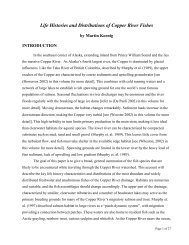Mitigation for the Construction and Operation of Libby Dam
Mitigation for the Construction and Operation of Libby Dam
Mitigation for the Construction and Operation of Libby Dam
You also want an ePaper? Increase the reach of your titles
YUMPU automatically turns print PDFs into web optimized ePapers that Google loves.
Introduction<br />
<strong>Libby</strong> <strong>Dam</strong>, on <strong>the</strong> Kootenai River, near <strong>Libby</strong>, Montana, was completed in 1972, <strong>and</strong><br />
filled <strong>for</strong> <strong>the</strong> first time in 1974. The dam was built <strong>for</strong> hydroelectric power production, flood<br />
control, <strong>and</strong> recreation. However, <strong>the</strong> socio-economic benefits <strong>of</strong> <strong>the</strong> construction <strong>and</strong><br />
operation <strong>of</strong> <strong>Libby</strong> <strong>Dam</strong> have come at <strong>the</strong> cost to <strong>the</strong> productivity <strong>and</strong> carrying capacity <strong>of</strong><br />
many <strong>of</strong> <strong>the</strong> native fish species <strong>of</strong> <strong>the</strong> Kootenai River Sub-basin. <strong>Libby</strong> Reservoir inundated<br />
109 stream miles <strong>of</strong> <strong>the</strong> mainstem Kootenai River in <strong>the</strong> United States <strong>and</strong> Canada, <strong>and</strong> 40<br />
miles <strong>of</strong> tributary streams in <strong>the</strong> U.S. that provided some <strong>of</strong> <strong>the</strong> most productive habitat <strong>for</strong><br />
spawning, juvenile rearing, <strong>and</strong> migratory passage. Historically, <strong>the</strong> fish residing downstream<br />
<strong>of</strong> <strong>Libby</strong> <strong>Dam</strong> could access quality spawning habitat upstream <strong>of</strong> <strong>Libby</strong> <strong>Dam</strong> in <strong>the</strong> United<br />
States <strong>and</strong> Canada. Impoundment <strong>of</strong> <strong>the</strong> Kootenai River blocked <strong>the</strong> migrations <strong>of</strong> fish<br />
populations that once migrated freely between Kootenai Falls (29 miles downstream <strong>of</strong> <strong>Libby</strong><br />
<strong>Dam</strong>) <strong>and</strong> <strong>the</strong> headwaters in Canada.<br />
<strong>Operation</strong>s <strong>of</strong> <strong>Libby</strong> <strong>Dam</strong> cause large fluctuations in reservoir levels <strong>and</strong> rapid daily<br />
fluctuations in volume <strong>of</strong> water discharged to <strong>the</strong> Kootenai River. Seasonal flow patterns in<br />
<strong>the</strong> Kootenai River have changed dramatically, with higher flows during fall <strong>and</strong> winter, <strong>and</strong><br />
lower flows during spring <strong>and</strong> early summer. Reservoir operations that cause excessive<br />
drawdowns <strong>and</strong> refill failure are harmful to aquatic life in <strong>the</strong> reservoir. Jenkins (1967)<br />
found a negative correlation between st<strong>and</strong>ing crop <strong>of</strong> fish <strong>and</strong> yearly vertical water<br />
fluctuations in 70 reservoirs.<br />
Problems occur <strong>for</strong> resident fish when <strong>Libby</strong> Reservoir is drawn down during late<br />
summer <strong>and</strong> fall, <strong>the</strong> most productive time <strong>of</strong> year. The reduced volume <strong>and</strong> surface area<br />
reduces <strong>the</strong> potential <strong>for</strong> providing <strong>the</strong>rmally optimal water volume during <strong>the</strong> high growth<br />
period, <strong>and</strong> limits production <strong>of</strong> fall-hatching aquatic insects. Surface elevations continue to<br />
decline during winter, arriving at <strong>the</strong> lowest point in <strong>the</strong> annual cycle during April. Deep<br />
drafts reduce food production <strong>and</strong> concentrate young trout with predators. Of greatest<br />
concern is <strong>the</strong> dewatering <strong>and</strong> desiccation <strong>of</strong> aquatic dipteran larvae in <strong>the</strong> bottom sediments.<br />
These insects are <strong>the</strong> primary spring food supply <strong>for</strong> westslope cutthroat, a species <strong>of</strong> special<br />
concern in Montana, <strong>and</strong> o<strong>the</strong>r important game <strong>and</strong> <strong>for</strong>age species. Deep drawdowns also<br />
increase <strong>the</strong> probability that <strong>the</strong> reservoirs will fail to refill. Refill failure negatively effects<br />
recreation <strong>and</strong> reduces biological production, which decreases fish survival <strong>and</strong> growth in <strong>the</strong><br />
reservoir (Marotz et al. 1996, Chisholm et al. 1989). Investigations by Daley et al. (1981),<br />
Snyder <strong>and</strong> Minshall (1996), <strong>and</strong> Woods <strong>and</strong> Falter (1982) have documented <strong>the</strong> declining<br />
productivity <strong>of</strong> <strong>the</strong> Kootenai System <strong>and</strong>, specifically, reduced downstream transport <strong>of</strong><br />
phosphorous <strong>and</strong> nitrogen by 63 percent <strong>and</strong> 25 percent, respectively.<br />
Large daily fluctuations in river discharge <strong>and</strong> stage (4-6 feet per day) str<strong>and</strong> large<br />
numbers <strong>of</strong> sessile aquatic insects in <strong>the</strong> varial zone (Hauer <strong>and</strong> Stan<strong>for</strong>d 1996). The<br />
reduction in magnitude <strong>of</strong> spring flows has caused increased embeddedness <strong>of</strong> substrates,<br />
resulting in loss <strong>of</strong> interstitial spaces in cobble <strong>and</strong> gravel substrates, <strong>and</strong> in turn, loss <strong>of</strong><br />
habitat <strong>for</strong> algal colonization <strong>and</strong> an overall reduction in species diversity <strong>and</strong> st<strong>and</strong>ing crop<br />
(Hauer <strong>and</strong> Stan<strong>for</strong>d 1996). Aquatic insects are affected by <strong>the</strong> reduction <strong>of</strong> microhabitat <strong>and</strong><br />
121
















